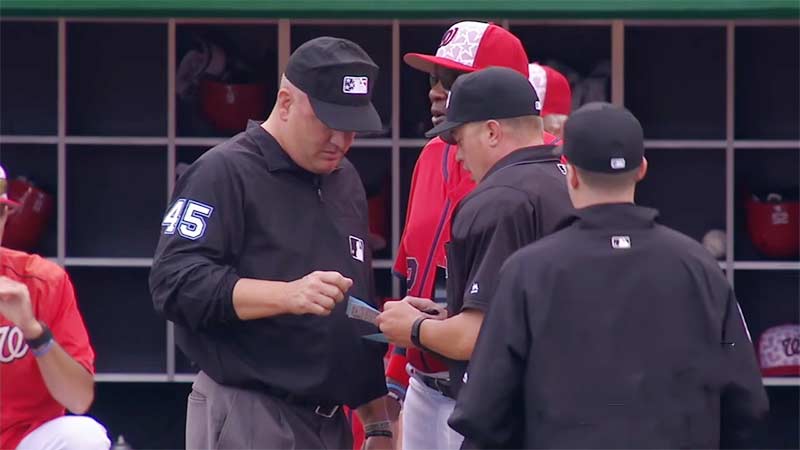In the intricate world of baseball, every detail matters, especially the batting order. Imagine the confusion and potential chaos when a player steps up to bat out of turn.
Batting out of order isn’t just a minor mistake; it disrupts the strategy meticulously planned by the manager and can lead to significant consequences during the game.
When a batter makes a plate appearance out of sequence from the lineup card, it can cause confusion and even penalties. The batting order, submitted to the home plate umpire before the game, dictates not only the sequence of hitters but also their assigned positions.
Ensuring each player bats in the correct order maintains the flow and fairness of the game, making any deviation a critical issue that teams must avoid.
Delving into the Rules: Understanding Batting Out of Turn
Batting out of turn in baseball happens when a player bats in a different order than what is listed on the lineup card given to the umpire before the game. It’s important for players, coaches, and fans to understand these rules to avoid mistakes.
The Basic Rules
Batting out of turn in baseball isn’t just a minor error; it has specific rules and consequences. According to rule 6.07(a), the batter who fails to bat in the proper order and is replaced by another who completes a time at bat can be called out upon appeal.
This rule ensures that the proper batter may take a position in the batter’s box before the improper batter becomes a runner or is put out. If this happens, any balls and strikes already called will count for the proper batter.
Key Points:
- The penalty for batting out of order is an out.
- The penalty applies when the incorrect batter completes a turn.
- The correct batter can replace the incorrect batter before the latter is put out or becomes a runner.
- Any balls and strikes called transfer to the correct batter if replaced timely.
The Importance of Batting Order
The batting order dictates the sequence of players at bat and is vital for game strategy. Managers submit this order before the game, and deviations can disrupt tactics, ensuring fairness and consistency.
Historical examples, like the 1943 Yankees game and a misapplied rule in 1894, show the significant impact of following the correct order. Adhering to the proper batting order preserves the game’s integrity and smooth flow, benefiting players, managers, and umpires.
Common Scenarios of Batting Out of Turn
Understanding the common scenarios of batting out of turn in baseball provides insight into how this error can occur and how it’s managed. Here are some typical situations:
Incorrect Batter at the Plate
Batting out of turn occurs when the batter at the plate isn’t listed in the official lineup. After a pitch is thrown, the umpire evaluates the batters in the lineup. If the current batter is incorrect, the team can replace them with the proper one, who assumes the existing count.
For instance, in a 1972 Braves vs. Phillies game, Marty Perez batted when Jim Breazeale was supposed to. Once a pitch was thrown, Breazeale replaced Perez to continue the at-bat.
Proper Batter Skipped
When a proper batter is skipped and a subsequent batter completes an at-bat, the written order remains unchanged. Once the improper batter’s appearance is legalized by a pitch to the next batter, the next batter in the lineup becomes the proper batter.
In 1932, during a Dodgers game, George Kelly and Al Lopez both batted out of turn. Kelly’s improper time legally placed him immediately after Lopez in the lineup, causing additional confusion but not altering the official order.
Substitution Errors
Substitution errors impact the batting order significantly. Suppose a team substitutes a player but fails to update the lineup correctly. This mistake can also lead to batting out of turn.
In a 1943 New York Yankees game, Joe Gordon, listed seventh in the official order, batted sixth due to a lineup given to the press. This difference led to protests and corrections, ultimately negating a run that could’ve led the Yankees to victory.
These scenarios highlight the intricacies and strategic importance of maintaining the correct batting order in baseball.
Consequences and Penalties
Understanding the consequences and penalties of batting out of turn in baseball is crucial for maintaining fair play and game integrity. Here’s an overview:
Immediate Game Impact
Batting out of turn can result in significant penalties, as illustrated by the 1988 Cincinnati Reds game. When the defensive team alerts the umpire, the incorrect batter is called out, and the correct batter must bat.
In this game, Pete Rose’s lineup discrepancy led to Chris Sabo batting instead of Dave Collins. After the Padres pointed out the error, Barry Larkin’s walk and Collins’ at-bat were nullified, and Eric Davis was called out, contributing to the Reds’ 9-2 loss.
Long-term Effects on the Game
Long-term effects can result from infractions such as batting out of turn, potentially altering game dynamics and team performance, and leading to outcomes like replaying games or nullifying results.
For example, in the 1932 Yankees-Tigers game, a lineup change led to the game being declared a no-decision despite the Yankees initially winning 6-3.
Similarly, during a 1943 Yankees game, Gordon’s out-of-turn batting negated his run, affecting the game’s outcome despite his later homer. These instances show how such infractions can influence game records and statistics.
Handling Batting Out of Turn
Handling batting out of turn in baseball requires swift and decisive action from umpires and teams. Here’s how it’s typically managed:
The Role of the Umpire
The umpire plays a crucial role in managing errors related to batting out of turn, ensuring the correct order based on the official lineup card. If an incorrect batter is identified before the next batter receives a pitch, the umpire corrects the order to maintain fairness.
Umpires also handle protests, such as in the 1932 Yankees-Tigers game, where Umpire Dick Nallin’s mid-game lineup switch led to a protest upheld by the AL President, highlighting the umpire’s impact on game rulings and outcomes.
How Teams Can Appeal
Teams can appeal if they suspect a batting order error but must do so before the next batter’s first pitch or any subsequent play. If a player, for example, hits a double, the defensive team can appeal immediately or after the next pitch.
The umpire will call out the incorrect batter if appealed immediately, and the proper batter will continue. Successful appeals negate advances or scores by the incorrect batter, while untimely appeals leave the play as it stands.
These decisions emphasize the importance of prompt and accurate appeals on game strategies.
Frequently Asked Questions
What are the consequences of batting out of turn in baseball?
Batting out of turn can lead to the batter being declared out if the opposing team alerts the umpire before the next pitch. Any advances or actions by runners resulting from the incorrect batter’s at-bat are nullified.
How do umpires handle batting out of turn?
Umpires ensure the correct batting order is maintained by confirming it before the game starts. If an error is pointed out by the opposing team before the next pitch, the umpire can rule the batter out and nullify any resulting advances.
Can teams appeal a batting order error after a pitch is thrown?
No, teams must appeal a batting order error before the next pitch is thrown. Once the next pitch is delivered, the opportunity to appeal and nullify the results of the incorrect batter’s actions is lost.
Are there any historical instances of batting out of turn?
Yes, notable examples include the 1988 Reds game, where a batting order error had significant immediate and long-term impacts on game outcomes, highlighting the importance of adhering to the correct batting order.
What role do umpires play in confirming the batting order?
Umpires play a crucial role in managing the batting order by confirming it at the start of the game and addressing any protests related to batting out of turn. Their rulings can significantly affect game dynamics and outcomes.
Conclusion
Understanding the intricacies of batting out of turn is essential for any baseball enthusiast. Knowing the rules and the role of the umpire can significantly impact game strategy and outcomes.
By paying close attention to the batting order and being prepared to appeal errors promptly, you can help ensure fair play and potentially influence the game’s direction.
Whether you’re a player, coach, or fan, being well-versed in these aspects can enhance your appreciation and enjoyment of the sport.
Additionally, familiarizing yourself with common scenarios and past precedents of batting out of turn can provide valuable insights. This knowledge not only sharpens your tactical acumen but also deepens your respect for the game’s complexities.








Pat Bloom